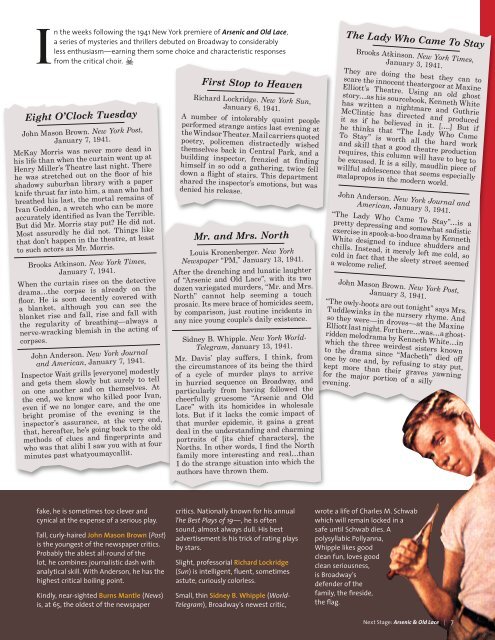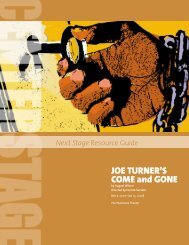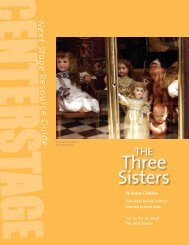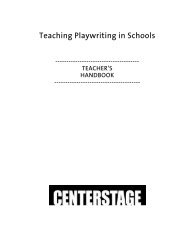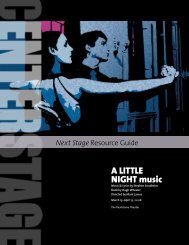Arsenic & Old lAce - Center Stage
Arsenic & Old lAce - Center Stage
Arsenic & Old lAce - Center Stage
Create successful ePaper yourself
Turn your PDF publications into a flip-book with our unique Google optimized e-Paper software.
In the weeks following the 1941 New York premiere of <strong>Arsenic</strong> and <strong>Old</strong> Lace,<br />
a series of mysteries and thrillers debuted on Broadway to considerably<br />
less enthusiasm—earning them some choice and characteristic responses<br />
from the critical choir. X<br />
The Lady Who Came To Stay<br />
Brooks Atkinson. New York Times,<br />
January 3, 1941.<br />
Eight O’Clock Tuesday<br />
John Mason Brown. New York Post,<br />
January 7, 1941.<br />
McKay Morris was never more dead in<br />
his life than when the curtain went up at<br />
Henry Miller’s Theatre last night. There<br />
he was stretched out on the floor of his<br />
shadowy suburban library with a paper<br />
knife thrust far into him, a man who had<br />
breathed his last, the mortal remains of<br />
Ivan Godden, a wretch who can be more<br />
accurately identified as Ivan the Terrible.<br />
But did Mr. Morris stay put? He did not.<br />
Most assuredly he did not. Things like<br />
that don’t happen in the theatre, at least<br />
to such actors as Mr. Morris.<br />
Brooks Atkinson. New York Times,<br />
January 7, 1941.<br />
When the curtain rises on the detective<br />
drama…the corpse is already on the<br />
floor. He is soon decently covered with<br />
a blanket, although you can see the<br />
blanket rise and fall, rise and fall with<br />
the regularity of breathing—always a<br />
nerve-wracking blemish in the acting of<br />
corpses.<br />
John Anderson. New York Journal<br />
and American, January 7, 1941.<br />
Inspector Wait grills [everyone] modestly<br />
and gets them slowly but surely to tell<br />
on one another and on themselves. At<br />
the end, we know who killed poor Ivan,<br />
even if we no longer care, and the one<br />
bright promise of the evening is the<br />
inspector’s assurance, at the very end,<br />
that, hereafter, he’s going back to the old<br />
methods of clues and fingerprints and<br />
who was that alibi I saw you with at four<br />
minutes past whatyoumaycallit.<br />
First Stop to Heaven<br />
Richard Lockridge. New York Sun,<br />
January 6, 1941.<br />
A number of intolerably quaint people<br />
performed strange antics last evening at<br />
the Windsor Theater. Mail carriers quoted<br />
poetry, policemen distractedly wished<br />
themselves back in Central Park, and a<br />
building inspector, frenzied at finding<br />
himself in so odd a gathering, twice fell<br />
down a flight of stairs. This department<br />
shared the inspector’s emotions, but was<br />
denied his release.<br />
Mr. and Mrs. North<br />
Louis Kronenberger. New York<br />
Newspaper “PM,” January 13, 1941.<br />
After the drenching and lunatic laughter<br />
of “<strong>Arsenic</strong> and <strong>Old</strong> Lace”, with its two<br />
dozen variegated murders, “Mr. and Mrs.<br />
North” cannot help seeming a touch<br />
prosaic. Its mere brace of homicides seem,<br />
by comparison, just routine incidents in<br />
any nice young couple’s daily existence.<br />
Sidney B. Whipple. New York World-<br />
Telegram, January 13, 1941.<br />
Mr. Davis’ play suffers, I think, from<br />
the circumstances of its being the third<br />
of a cycle of murder plays to arrive<br />
in hurried sequence on Broadway, and<br />
particularly from having followed the<br />
cheerfully gruesome “<strong>Arsenic</strong> and <strong>Old</strong><br />
Lace” with its homicides in wholesale<br />
lots. But if it lacks the comic impact of<br />
that murder epidemic, it gains a great<br />
deal in the understanding and charming<br />
portraits of [its chief characters], the<br />
Norths. In other words, I find the North<br />
family more interesting and real…than<br />
I do the strange situation into which the<br />
authors have thrown them.<br />
They are doing the best they can to<br />
scare the innocent theatergoer at Maxine<br />
Elliott’s Theatre. Using an old ghost<br />
story…as his sourcebook, Kenneth White<br />
has written a nightmare and Guthrie<br />
McClintic has directed and produced<br />
it as if he believed in it. [….] But if<br />
he thinks that “The Lady Who Came<br />
To Stay” is worth all the hard work<br />
and skill that a good theatre production<br />
requires, this column will have to beg to<br />
be excused. It is a silly, maudlin piece of<br />
willful adolescence that seems especially<br />
malapropos in the modern world.<br />
John Anderson. New York Journal and<br />
American, January 3, 1941.<br />
“The Lady Who Came To Stay”…is a<br />
pretty depressing and somewhat sadistic<br />
exercise in spook-a-boo drama by Kenneth<br />
White designed to induce shudders and<br />
chills. Instead, it merely left me cold, so<br />
cold in fact that the sleety street seemed<br />
a welcome relief.<br />
John Mason Brown. New York Post,<br />
January 3, 1941.<br />
“The owly-hoots are out tonight” says Mrs.<br />
Tuddlewinks in the nursery rhyme. And<br />
so they were—in droves—at the Maxine<br />
Elliott last night. For there…was…a ghostridden<br />
melodrama by Kenneth White…in<br />
which the three weirdest sisters known<br />
to the drama since “Macbeth” died off<br />
one by one and, by refusing to stay put,<br />
kept more than their graves yawning<br />
for the major portion of a silly<br />
evening.<br />
fake, he is sometimes too clever and<br />
cynical at the expense of a serious play.<br />
Tall, curly-haired John Mason Brown (Post)<br />
is the youngest of the newspaper critics.<br />
Probably the ablest all-round of the<br />
lot, he combines journalistic dash with<br />
analytical skill. With Anderson, he has the<br />
highest critical boiling point.<br />
Kindly, near-sighted Burns Mantle (News)<br />
is, at 65, the oldest of the newspaper<br />
critics. Nationally known for his annual<br />
The Best Plays of 19—, he is often<br />
sound, almost always dull. His best<br />
advertisement is his trick of rating plays<br />
by stars.<br />
Slight, professorial Richard Lockridge<br />
(Sun) is intelligent, fluent, sometimes<br />
astute, curiously colorless.<br />
Small, thin Sidney B. Whipple (World-<br />
Telegram), Broadway’s newest critic,<br />
wrote a life of Charles M. Schwab<br />
which will remain locked in a<br />
safe until Schwab dies. A<br />
polysyllabic Pollyanna,<br />
Whipple likes good<br />
clean fun, loves good<br />
clean seriousness,<br />
is Broadway’s<br />
defender of the<br />
family, the fireside,<br />
the flag.<br />
Next <strong>Stage</strong>: <strong>Arsenic</strong> & <strong>Old</strong> Lace |


